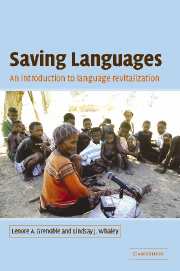3 - Models for revitalization
Published online by Cambridge University Press: 04 December 2009
Summary
Introduction
This chapter discusses common types of revitalization programs found world-wide, what these programs involve, and how they match (or fail to match) the language goals of a given community. The choice of the best program for a particular community is primarily dependent upon these goals, but the resources available for the project are also critical. We limit our discussion in this chapter to the portions of programs that deal specifically with increasing local language knowledge and use. However, it must be kept in mind that the language portion of the program must be complemented by fund-raising, political lobbying, legal work, and/or community relations efforts.
Most communities involved in revitalization have chosen to focus at least some of their efforts in educational programs. This chapter uses this fact to organize the presentation of revitalization programs. Existing types range from full immersion programs, where all instruction is in the local language, such as the Hawaiian and Māori “language nests,” to partial-immersion programs, where local language instruction is found in conjunction with instruction in a language of wider communication, to programs where use of the local language is very limited.
While many would argue that full-immersion programs are the surest route to language revitalization and maintenance, few communities have the resources necessary to see them through.
- Type
- Chapter
- Information
- Saving LanguagesAn Introduction to Language Revitalization, pp. 50 - 68Publisher: Cambridge University PressPrint publication year: 2005



